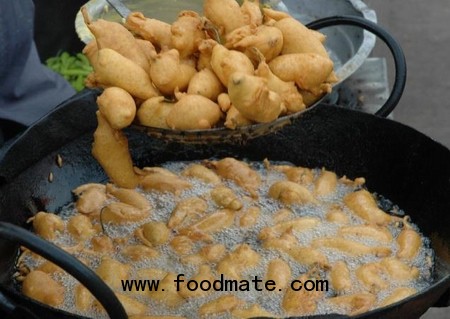
I used to work in an office with late hours and a chaotic day, sometimes with no time for lunch. Particularly on rainy days, we’d first request, then beg, then browbeat DS, the admin factotum, to send out Jeetu, the only peon on a scooter, for pakoras. The best were at Nauroji Nagar, not too far from the office. Now “best” is a relative word. These were not delicate, fine specimens; the besan (milled chickpea or Bengal gram) batter was very thick — it formed not a light jacket but a thick duffel-coat — on the vegetable of choice. They would arrive, wrapped in newspaper in a plastic bag, with little rubber-banded sachets of chutney that challenged you to eat them, risking cholera, or to settle tamely for bottled ketchup.
The office’s favourites were of potato, onion rings, and cauliflower. Mine were “mixed”: an unevenly shaped blob of finely chopped potatoes, onions, methi (fenugreek) leaves and green chillies stirred into the besan batter and fried twice till brown and crisp. The oil — for all the pakoras — had been used not just twice, but maybe an infinite number of times. I strongly suspect the flavour, un-replicable at home, came from the black trans-fats and carcinogens that the reusing and diesel fumes imparted. DS always remembered that I like mirchi pakoras: large green chillies, slit and filled with mashed potato masala, then dipped in batter and fried. These could burn the tongue and it was difficult to drink tea after.
Sometimes we’d phone the nearest “restraunt”, Gulnar, whose wrapped-in-polythene menu had become illegible with oil smears. They had Chinese (“nuddles”) and Indian food. The best teatime snack was anda pakora. Hardboiled eggs, cut lengthwise, were besan batter-fried, sprinkled with chat masala, and delivered within ten minutes. Unless Lovely, the proprietress, who also ran the Gulnar Beauty Parlour (which should have been called el Grotto) next door, was busy heating wax on the stove that was needed for cooking. Crisp and golden, with sometimes little projections of darker, crisper boondi stuck to the egg oblongs, they were so good that they must have been sinful.
Exceptional food and view
My strongest associations with pakoras, bhajis, bhajias, are monsoon rain and the hills. Just short of Kufri is a village called Chharabra which I only know for its tea shop. You can sit inside the dark, dank little room, or on a parapet outside, which gives a cliff-side view of the Himalayas, complete with deodars and firs where you can dangle your legs with nothing between you and the valley below but thick billows of mist. There isn’t a menu card: all they make are pakoras and tea. The tea is exceptional, like the view; for cooked, milky, sweet tea, this one is drinkable. The owner/chef adds some ground green cardamom seeds; the sugar is light, the tea scalding. The pakoras are the chopped and mixed kind: sliced onions stirred into a thin batter of besan and fried at just the right temperature. The onion pieces are odd-shaped and stick out at angles from the centre, so the thin projections get crisper and browner. The caramelised onions are sweetish, the seasoned batter sharp and savoury. You can spend hours alternately sipping sweet tea and crunching crisp, salty pakoras, gazing all the while at the distant snows, pink in the sunset.
One summer I was camping in the Shimla hills with my parents when we decided to visit friends who were staying the summer at Dane’s Folly, the governor’s summer retreat. We just landed up without warning and they produced tea, with pakoras. Not a surprising menu, given the location and the weather. The surprise was the vegetable wrapped in the pakora: ghiya, lauki. It was cut into thin rectangles and the batter was light and crisp. The hostess said she added baking soda to the batter. I’ve always imagined that soda would make the batter porous and induce it to soak oil and have never tried using it, but what we ate there was delicious.
I’m not the world’s champion fryer, but I’ve learnt that besan is a sturdy flour and can take some frying. Unlike maida whose fritters can brown and burn too easily, besan pakoras are less delicate. What can add delicacy, though, is the thinness of the batter covering. So if making “mixed” pakoras of chopped vegetables, or of sliced potatoes, onions or aubergines, the batter should be as thin as possible, one that will just hold everything together or coat the vegetable slice. Because the more besan you add to water, the more solid and dense does the pakora become. But since the purpose of the batter is to add a crisp shell and to prevent the vegetable from drinking oil, I stir a little besan into water (with salt and maybe red chilli powder) and test if it holds. After that, the first frying must be done quickly, because the salt in the batter is going to make the veggies sweat and dilute the batter further. So while the batter is being mixed, oil in a karahi should be heating, almost to smoking. I like mustard oil, but that is a matter of personal taste — any vegetable oil does as well. Pakoras of whole spinach leaves, palak, are best in this kind of batter. It’s actually a virtue if the batter is too thin to coat a whole leaf, because then what you fry up is a thin golden spade with dark green peeping through windows in the shell.





